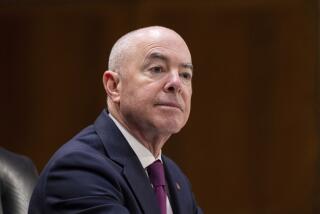Unscripted, Senate Starting to Flub a Few Lines
- Share via
WASHINGTON — A pack of reporters with empty-notebook syndrome was parked outside the Republican caucus room Monday when Sen. Conrad R. Burns of Montana emerged. Realizing that there was no escape, he headed purposefully toward an empty elevator. But reporters cut him off.
“It’s my birthday,” he said in a hapless cry for mercy.
“Happy Birthday,” a couple of them snorted, then they mobbed him. He jumped on the elevator and barked at the operator: “Press the button already!”
On the opening day of week three of the Senate impeachment trial, the press demanded to know the unknowable: What is going to happen next? Burns cannot tell them. Nobody can tell them. Nobody knows. For the first time since the trial opened, the venerable, ceremonial Senate is working without a script, flying without a net.
And the senators hate it.
“I spoke my piece, and now I want a piece of my birthday cake,” Burns demurred as the elevator doors closed.
Two weeks ago, senators set up a bipartisan plan to start the trial and leave for later the vexing question of whether to call witnesses. Now both sides have argued their cases, and it is time to decide whether to bring, among others, the reluctant Monica S. Lewinsky before the Senate.
This is a time like no other for a Senate that lives and dies by decorum. Rarely does this elite club of 100 begin a day without a pretty good idea of how it will end. Senate Majority Leader Trent Lott (R-Miss.) runs the place as neatly as his coiffed hair. Senators are accustomed to eating lunch with white tablecloths and linen napkins in their august private dining room, not from red, white and blue boxes of Domino’s pizza.
But this body now is like a box turtle on its back, legs flailing, struggling to right itself. Senators are groping desperately for a graceful way to bring down the impeachment curtain and pay homage to the opinion polls.
On Monday morning, it looked like they might have a plan--a bipartisan deal in which Republicans would agree to call no witnesses and Democrats would drop their motion to dismiss the trial. Senators would vote Friday on the charges, thus ending what former Sen. Dale Bumpers (D-Ark.), who delivered an impassioned speech for the defense team last week, called a “national nightmare.”
“A mutual withdrawal of forces,” Sen. Joseph I. Lieberman (D-Conn.), a sponsor of the proposal, declared optimistically. “We can do this by the end of the week and get back to our regular business next week. That’s the hope . . . and prayer.”
But at 12:15 p.m. Lott’s spokesman emerged in a hallway, his back literally pressed to the wall by a mob of reporters.
“The idea has been summarily rejected by Sen. Lott and the caucus,” John Czwartacki croaked.
“This has been wearing on the senators in particular,” an aide said. “No one knows what is going to happen. . . . Even the leaders don’t know how it’s going to play out.”
It was clear something was amiss, when the appointed 2 p.m. convening hour struck and most of the seats were empty. The one thing unique about this impeachment episode is that it has compelled every U.S. senator to be on time, pens out, eyes forward. But Monday, they were trying to strike a deal outside the chamber, huddled in groups that kept shifting.
Chief Justice William H. Rehnquist called the chamber to order. Lott was at his podium but his counterpart, Minority Leader Tom Daschle (D-S.D.), was nowhere to be found. Sen. Barbara A. Mikulski (D-Md.) stood in for Daschle.
Nobody knew what to do.
Lott announced a quorum call, the equivalent of a sandlot “timeout,” while opposing forces buy time to figure out their next move. The Senate clerk slowly read the names of all 100 senators.
A few minutes later, the missing group had returned. But Sen. Tom Harkin (D-Iowa) wanted to object. Could he? Lott looked baffled. Rehnquist looked stumped.
Quorum call!
Recomposed, Lott took the podium and announced, fatigued yet triumphant: “Welcome to the operation of the United States Senate.”
The body language alone spoke volumes. On the floor during one of the timeouts, the leaders were in the middle of the chamber haggling over a procedural nit, with 20 senators elbowing in to hear the debate. Sen. Orrin G. Hatch (R-Utah) leaned in from his chair, got wind of what was being said, closed his eyes, grimaced and wiped his brow.
Harkin, frustrated in his attempt, was led from the chamber by a fellow Democrat who patted his shoulder soothingly as they walked to the cloakroom.
By the end of the day, the Senate had shut its doors. Citizens in the gallery who had waited in long lines for a glimpse of the action were shown the exits according to a little-known 19th-century holdover called Rule 29. Any senator who tells what happens behind the closed doors is subject to “pain of expulsion.”
Harkin, who co-sponsored a motion to keep the proceedings open, cried foul.
“This is not a private club,” he thundered. “The taxpayers are paying for this.”
More to Read
Get the L.A. Times Politics newsletter
Deeply reported insights into legislation, politics and policy from Sacramento, Washington and beyond. In your inbox twice per week.
You may occasionally receive promotional content from the Los Angeles Times.










